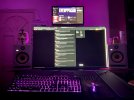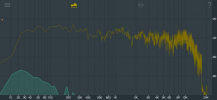In terms of goals and intent, they are different, and
@Jim Taylor summed it up well.
The goal of a studio monitor is to show you what's in the mix. The goal of a hifi speaker is to sound as good as possible. Somewhat by chance(or not), it just so happens that those 2 goals have the exact same solution.
The best way to show what's in the mix is to make a monitor that is as neutral as possible. The best way to sound great is to make a speaker that is as neutral as possible. This is quite convenient for us consumers, as it gives us many more options

.
In my experience, the pro world tends to be a bit better(on average) at achieving their goal. Since both goals have the same solution, this also means that studio monitors tend to sound better for hifi than hifi speakers at the same price point, though it depends on the price point.
Something like the JBL 308p @ $300/pair or the Kali LP 6 V2 @ $400/pair are almost impossible to beat in the passive world(at least I've never found it). In fact, I don't have a passive speaker under $1,000 that I'd choose over the 308p in a blind test, at least before dealer discount. The cheapest speakers I own that beat(confirmed with blind test) the 308p is the Revel M105 and M106, but then I prefer the Genelec 8030c over those. Revel M105 could possibly go for less than $1000 with a good dealer.
This definitely depends on the price point, though. There are exceptions at different price points. For example, I can't think of any active that gives the great combination of extension and wide dispersion as the Philharmonic BMR Tower. Another example, I can't think of anything I'd take over the Revel F208 with dealer pricing. There are certainly more examples. Revel and KEF speakers are almost always up there with the best studio monitors at their price point.
Passive speakers do have other advantages, though:
1. Tower speakers - for some reason, tower speakers are super rare in the pro audio world, and tower speakers do offer real advantages (output, extension) over bookshelf speakers.
2. Aesthetics - usually passive speakers have more care given to the way they look, often with gloss finishes and/or vinyl wrap.
3. Cheaper to hook up for Home Theater - Cheapest way to build a multichannel HT system is via an AVR. 7 channel AVRs can be found for below $300, but those don't have pre-outs. AVRs that can connect to studio monitors are much more expensive.
4. Longevity - In some way, this kinda depends on listening habits. If you almost never crank up the volume to super high levels, a passive speaker should last quite a bit longer. A good active might only last for 20 years or so, whereas a passive can often last twice that long. For me, I seem to listen too loud on occasion, so actives actually tend to last longer for me

.
5. Less cabling - passive speakers only need speaker cables. Active speakers need 2 cables for every speaker.



